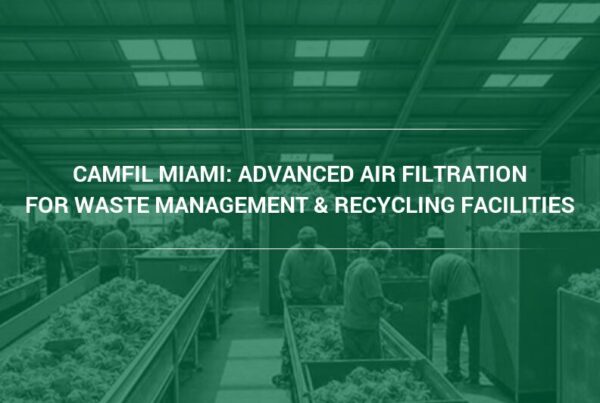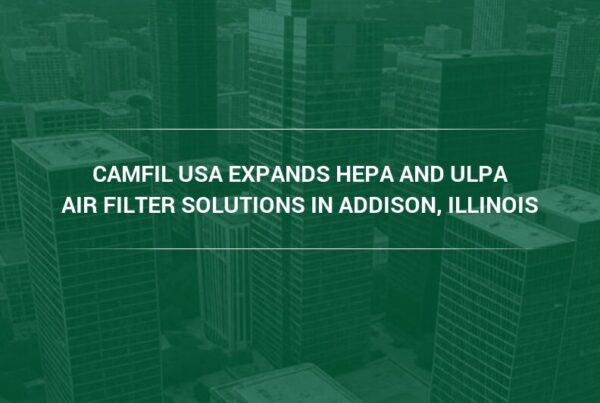Camfil USA air filters have created a new blog post that educates on how to combat air pollution in offices to increase productivity.
It is common knowledge that air pollution is bad for people’s health, but it can also impact people’s productivity. Air pollution in offices can lead to less productivity, largely because of the negative effects on the health of office workers. This means that improving air quality in offices will also improve the productivity of workers. Why does air pollution harm productivity, and what tactics can be employed to raise both air quality and productivity?
Health Impacts of Air Pollution in Offices
“The Occupational Safety and Health Administration (OSHA) explains that the health impacts of air pollution in offices can include fever, shortness of breath, cough, headaches, and general tiredness,” says Kevin Wood, Vice President Sales & Marketing at Camfil USA
. “In some cases, more serious conditions such as asthma and pneumonia have been linked to poor air quality in offices. Symptoms that occur at work but disappear when one leaves work are likely indicators of air quality problems in the workplace.” (1)
Health conditions associated with indoor air pollution are caused by indoor air pollutants such as mold, vapor from cleaning chemicals, humidity, dust, cigarette smoke, and emissions from heating or air-conditioning systems. Lack of adequate ventilation exacerbates these problems.
The health impacts of indoor air pollution depend on the type of pollutant a person is exposed to and for how long they are exposed to it. Exposure to high levels of pollutants over extended periods of time can even lead to the development of life-threatening illnesses like cancer, this is particularly true of cigarette smoke or other particulate pollution. Other pollutants such as carbon monoxide can lead to death within minutes if concentrations of it in the air are high.
The health impacts of indoor air pollutants are also dependent upon the biology of the individual. Some people will not have severe allergic reactions to certain pollutants, but other people will. Exposure to low levels of chemicals can trigger asthmatic reactions in some people, but not in others. Those with pre-existing conditions are at particular risk for exposure to indoor air pollutants.
Effects of Air Pollution in Offices on Productivity
The effects of air pollution in offices on productivity have been studied, and study after study has confirmed that air pollution is negatively correlated with worker productivity. The better the air quality is, the better the average worker will perform.
“One recent study done by Harvard business review found that the average worker is 5 to 6% more productive when the air they work in is rated as good by the EPA, as opposed to working in air rated as unhealthy by the EPA,” says Wood. “This fact remained constant even when outdoor air pollution levels were fairly low.” (2)
A separate study by Syracuse University and Harvard University corroborated these findings. It tested employees in a variety of different pollution levels, using multiple testing areas which had different levels of carbon dioxide. The employees who worked in the low pollution condition performed their tasks 60% better than a group who was tested under standard pollution levels.
This phenomenon is attributable to the health impacts that poor air quality has. When workers are feeling ill, stricken with a cough, headaches, or other symptoms they perform worse. Beyond that, particulate matter can often be absorbed into the bloodstream where it can travel to the brain itself, causing inflammation of the central nervous system. Heightened exposure to fine particle pollution is correlated with diminished performance in cognitive tasks and general intelligence.
Positive air quality leads to better health. Employees who work in green-certified buildings often experience fewer headaches and respiratory issues than their counterparts in more polluted buildings.
Combating Air Pollution in Offices
Combating air pollution in offices must be done by management, maintenance, and employees alike. Good air quality is a shared responsibility, and it affects everyone. Management and maintenance should ensure that ventilation systems are functioning properly, and employees can ensure that any spills or accidents that generate air pollution are reported to the proper authorities.
Office building occupants can ensure that air vents are not blocked, that any spills or damaged equipment are reported, that all garbage is properly disposed of, and that chemical cleaners are properly used and stored. Sources of air pollution should be quickly removed from the building, or isolated if removal is not possible.
“Management and maintenance team should work together to be certain that HVAC systems are properly installed and maintained, that air filters are not clogged, and that water is not pooling in ducts or vents,” said Wood. “Regular inspections should be done to ensure that heating and cooling systems are functioning properly, that no dust or debris from construction is accumulating, and that leaks or floods are responded to in a timely and efficient manner.” (3)
Air pollution in offices is a serious problem that impacts people’s health and livelihood, not just productivity. All occupants of a building should work together to educate one another on the dangers of air pollution, and to make sure that indoor air quality remains high.
If your office needs a professional consultation to purchase filters to fight air pollution in offices, contact Camfil as soon as possible.
SOURCES
https://www.osha.gov/SLTC/indoorairquality/faqs.html
https://hbr.org/2016/09/air-pollution-is-making-office-workers-less-productive
https://www.epa.gov/indoor-air-quality-iaq/office-building-occupants-guide-indoor-air-quality



